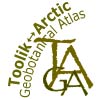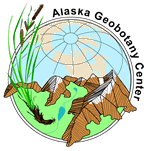Toolik Lake Permanent Vegetation Plots
Walker D.A. and Barry N. 1991. Toolik Lake permanent vegetation plots: site factors, soil physical and chemical properties, plant species cover, photographs, and soil descriptions. Data Report 48, Department of Energy R4D Program, Institute of Arctic and Alpine Research, University of Colorado, Boulder, CO.
Home //
Plot location map //
Preliminary vegetation classification //
Communities and microsites //
Environmental variables //
Environmental information: Abiotic data,
Biotic data //
Soils Characteristics //
Species Composition //
Selected Soil Descriptions //
Plot Photos
Table 3. Legend for the environmental variables
PDF - MS Word
| Landforms |
|---|
| 1 | Glaciofluvial and other fluvial terraces |
|---|
| 2 | Floodplains |
|---|
| 3 | Talus slope |
|---|
| 4 | Colluvial basin |
|---|
| 5 | Drained lakes and flat lake margins |
|---|
| 6 | Lake or pond |
|---|
| 7 | Hills (including kames and moraines) |
|---|
| 8 | Disturbed |
|---|
|
| Microsites |
|---|
| 1 | Frost-scar element |
|---|
| 2 | Inter-frost scar element |
|---|
| 3 | Strang or hummock |
|---|
| 4 | Flark or interstrang area |
|---|
| 5 | Polygon center |
|---|
| 6 | Polygon trough |
|---|
| 7 | Stripe element |
|---|
| 8 | Inter-stripe element |
|---|
| 9 | Animal den |
|---|
| 10 | Blockfield |
|---|
|
| |
| Surficial Geology |
|---|
| 1 | Glacial till |
|---|
| 2 | Glaciofluvial deposit |
|---|
| 3 | Active alluvium |
|---|
| 4 | Stabilized alluvium |
|---|
| 5 | Stream |
|---|
| 6 | Undifferentiated hill slope colluvium |
|---|
| 7 | Basin colluvium and organic deposits |
|---|
| 8 | Drained lake or lacustrine deposits |
|---|
| 9 | Lake or pond |
|---|
| 10 | Roads and gravel pads |
|---|
|
| Topographic Position |
|---|
| 1 | Hill crest or shoulder |
|---|
| 2 | Side slope |
|---|
| 3 | Footslope or toeslope |
|---|
| 4 | Flat |
|---|
| 5 | Drainage channel |
|---|
| 6 | Depression |
|---|
| 7 | Lake or pond |
|---|
|
| |
| Glacial Geology |
|---|
| 1 | Itkillik I till |
|---|
| 2 | Itkillik II till |
|---|
| 3 | Itkillik I outwash |
|---|
| 4 | Itkillik II outwash |
|---|
| 5 | Bedrock |
|---|
|
| Estimated Snow Duration |
|---|
| 1.0 | Snow free all year |
|---|
| 2.0 | Snow free most of the winter; some snow cover persists after storm but is blown free soon afterward |
|---|
| 3.0 | Snow free prior to melt out but with snow most of winter |
|---|
| 4.0 | Snow free immediately after melt out |
|---|
| 5.0 | Snow bank persists 1-2 weeks after melt out |
|---|
| 6.0 | Snow bank persists 3-4 weeks after melt out |
|---|
| 7.0 | Snow bank persists 4-8 weeks after melt out |
|---|
| 8.0 | Snow bank persists 8-12 weeks after melt out |
|---|
| 9.0 | Very short snow free period |
|---|
| 10.0 | Deep snow all year |
|---|
|
| |
| Surficial Geomorphology |
|---|
| 1 | Frost scars |
|---|
| 2 | Wetland hummocks |
|---|
| 3 | Turf hummocks |
|---|
| 4 | Gelifluction features |
|---|
| 5 | Strangmoor or aligned hummocks |
|---|
| 6 | High centered polygons or flat centered polygons |
|---|
| 7 | Sorted and non-sorted stripes |
|---|
| 8 | Palsas |
|---|
| 9 | Thermokarst pits |
|---|
| 10 | Featureless or with < 20% frost scars |
|---|
| 11 | Well-developed hillslope water tracks and small streams > 50 cm deep |
|---|
| 12 | Poorly developed hill slope water tracks, < 50 cm deep |
|---|
| 13 | Gently rolling or irregular microrelief |
|---|
| 14 | Stoney surface |
|---|
| 15 | Lakes and ponds |
|---|
| 16 | Disturbed |
|---|
| 17 | Blockfield |
|---|
|
| |
| Exposure Scale |
|---|
| 1.0 | Protected from winds |
|---|
| 2.0 | Moderate exposure to winds |
|---|
| 3.0 | Exposed to winds |
|---|
| 4.0 | Very exposed to winds |
|---|
|
| Stability |
|---|
| 1.0 | Stable |
|---|
| 2.0 | Subject to occasional disturbance |
|---|
| 3.0 | Subject to prolonged but slow disturbance such as solifluction |
|---|
| 4.0 | Annually disturbed |
|---|
| 5.0 | Disturbed more than once annually |
|---|
|
| |
| Site Moisture (modified from Komárková 1983) |
|---|
| 1.0 | Extremely xeric - almost no moisture; no plant growth |
|---|
| 2.0 | Very xeric - very little moisture; dry sand dunes |
|---|
| 3.0 | Xeric - little moisture; stabilized sand dunes, dry ridge tops |
|---|
| 4.0 | Subxeric - noticeable moisture; well-drained slopes, ridges |
|---|
| 5.0 | Subxeric to mesic - very noticeable moisture; flat to gently sloping |
|---|
| 6.0 | Mesic - moderate moisture; flat or shallow depressions |
|---|
| 7.0 | Mesic to subhygric - considerable moisture; depressions |
|---|
| 8.0 | Subhygric - very considerable moisture; saturated but with < 5 % standing water < 10 cm deep |
|---|
| 9.0 | Hygric - much moisture; up to 100% of surface under water 10 to 50 cm deep; lake margins, shallow ponds, streams |
|---|
| 10.0 | Hydric - very much moisture; 100% of surface under water 50 to 150 cm deep; lakes, streams |
|---|
|
| Soil Units |
|---|
| 1 | Pergelic Cryorthent, acid |
|---|
| 2 | Pergelic Cryohemist, euic |
|---|
| 3 | Pergelic Cryosaprist, euic |
|---|
| 4 | Lithic Pergelic Cryosaprist |
|---|
| 5 | Pergelic Cryofibrist, euic |
|---|
| 6 | Histic Pergelic Cryaquept, acid |
|---|
| 7 | Histic Pergelic Cryaquept, nonacid |
|---|
| 8 | Pergelic Cryaquept, acid |
|---|
| 9 | Pergelic Cryaquept, nonacid |
|---|
| 10 | Pergelic Cryochrept |
|---|
| 11 | Pergelic Cryumbrept |
|---|
| 12 | Ruptic-Lithic Cryumbrept |
|---|
| 13 | Pergelic Cryaquoll |
|---|
| 14 | Histic Pergelic Cryaquoll |
|---|
| 15 | Pergelic Cryoboroll |
|---|
|
| |
| Animal and Human Disturbance |
|---|
| 0.0 | No sign present |
|---|
| 1.0 | Some sign present; no disturbance |
|---|
| 2.0 | Minor disturbance or extensive sign |
|---|
| 3.0 | Moderate disturbance; small dens or light grazing |
|---|
| 4.0 | Major disturbance; multiple dens or noticeable trampling |
|---|
| 5.0 | Very major disturbance; very extensive tunneling or large pit |
|---|
|
| Soil Moisture (modified from Komárková 1983) |
|---|
| 1.0 | Very dry - very little moisture; soil does not stick together |
|---|
| 2.0 | Dry - little moisture; soil somewhat sticks together |
|---|
| 3.0 | Damp - noticeable moisture; soil sticks together but crumbles |
|---|
| 4.0 | Damp to moist - very noticeable moisture; soil clumps |
|---|
| 5.0 | Moist - moderate moisture; soil binds but can be broken apart |
|---|
| 6.0 | Moist to wet - considerable moisture; soil binds and sticks to fingers |
|---|
| 7.0 | Wet - very considerable moisture; drops of water can be squeezed out of soil |
|---|
| 8.0 | Very wet - much moisture can be squeezed out of soil |
|---|
| 9.0 | Saturated - very much moisture; water drips out of soil |
|---|
| 10.0 | Very saturated - extreme moisture; soil is more liquid than solid |
|---|
|
| |



